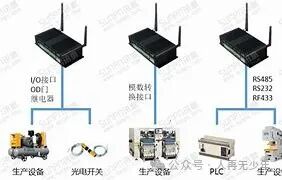
unsetunsetIntroductionunsetunset
Last week, I encountered a real project failure where Old Zhang’s robotic arm suddenly started dancing, and the PLC data could not be transmitted to the cloud. Today, let’s discuss how to use a $20 ESP32 module to handle both PLC’s RS485 communication and cloud data integration. No need for high-end gateways; follow me from hardware wiring to cloud configuration, and I’ll guide you to avoid the pitfalls I’ve encountered.
unsetunset1. Project Background and Requirement Analysisunsetunset
A certain injection molding workshop needs to upload production data from 10 Mitsubishi FX3U PLCs to Alibaba Cloud in real-time, while also supporting viewing via a WeChat mini-program. Traditional industrial gateways cost thousands, so we decided to build an IoT gateway using the ESP32.
Technical Highlights:
- RS485 Communication: Read PLC register data (Modbus RTU protocol)
- WiFi Networking: MQTT protocol integration with Alibaba Cloud IoT platform
- Data Relay: Local caching + offline data transmission
- Real-time Response: Simultaneously handle cloud commands and local data collection
unsetunset2. Three Major Pitfalls in Hardware Setupunsetunset
2.1 The “Love Triangle” of Communication Interfaces
Problem Phenomenon: ESP32’s Serial Port 0 (UART0) is used for both RS485 communication and printing debug information, resulting in garbled data.
Solution:
// Use Serial Port 2 specifically for RS485 communication
#define RXD2 16
#define TXD2 17
HardwareSerial Serial485(2);
void setup() {
Serial.begin(115200); // Debugging Serial Port 0
Serial485.begin(9600, SERIAL_8N1, RXD2, TXD2); // PLC communication serial port
}Key Points of Hardware Wiring Diagram:
ESP32 GPIO16 -> MAX485 Module RO
ESP32 GPIO17 -> MAX485 Module DI
MAX485 Module A/B -> PLC Programming Port A/B
Note: Be sure to connect a 120Ω termination resistor in parallel between A/B lines!2.2 The “Vampire” Phenomenon of Power Supply
Pitfall Record: The first batch of devices crashed after running for 2 hours on-site, and the MAX485 chip was hot enough to fry an egg.
Improvement Plan:
- Use an isolated DC-DC module (Jinshengyang WRB2405)
- Add a TVS diode (SMBJ6.0CA) to the RS485 interface
- Connect a 1000μF + 0.1μF capacitor in parallel at the power input
unsetunset3. Five Secrets of Software Designunsetunset
3.1 Modbus Protocol Parsing Techniques
Typical Error: Directly using third-party libraries leads to response timeouts
Optimized Code:
// Custom CRC check function (3 times faster than library function)
uint16_t crc16(uint8_t *buffer, uint8_t length) {
uint16_t crc = 0xFFFF;
for(int pos=0; pos<length; pos++) {
crc ^= (uint16_t)buffer[pos];
for(int i=8; i!=0; i--) {
if((crc & 0x0001) != 0) {
crc >>= 1;
crc ^= 0xA001;
} else {
crc >>= 1;
}
}
}
return crc;
}3.2 Dual-Thread Processing Solution
Pain Point: Simultaneously handling network and serial port leads to data loss
FreeRTOS Task Configuration:
xTaskCreatePinnedToCore(
plcTask, // PLC communication task
"PLC_Task",
4096,
NULL,
3,
NULL,
0); // Run on core 0
xTaskCreatePinnedToCore(
cloudTask, // Cloud task
"Cloud_Task",
4096,
NULL,
2,
NULL,
1); // Run on core 1unsetunset4. Practical Techniques for Cloud Integrationunsetunset
4.1 Alibaba Cloud Trio Configuration
Common Mistake: Directly copying keys leads to character escape errors
// Correct syntax (note to keep the semicolon)
#define PRODUCT_KEY "a1wTxxxxxxxx"
#define DEVICE_NAME "ESP32_Gateway_01"
#define DEVICE_SECRET "fae8d9c6b5a4f3e2d1c0b9a8f7e6d5c"4.2 WeChat Mini-Program Development Shortcuts
Data Push Solutions:
- Alibaba Cloud → Cloud Function → WeChat Template Message
- WebSocket direct connection solution (requires HTTPS certificate)
- Third-party push platforms (e.g., PushPlus)
unsetunset5. Lifesaving Tips for On-Site Debuggingunsetunset
5.1 DIY Solutions for Signal Interference
Typical Scenario: Modbus data becomes chaotic when the frequency converter starts
Emergency Measures:
- Wrap the RS485 cable with aluminum foil
- Connect a 0.1μF ceramic capacitor in parallel at the PLC end
- Change the baud rate from 9600 to 19200
5.2 Four-Step Analysis for Data Packet Loss
- Use a USB to RS485 tool to directly connect to the PLC to verify the original data
- Print the original message on the ESP32 serial port
- Use Wireshark to analyze MQTT traffic
- Use Alibaba Cloud log service to trace data
unsetunset6. Hard Lessons Learned (Must Read!)unsetunset
- Isolation Power Supply Burnout Incident: Used a non-isolated module to save costs, resulting in the PLC serial port burning out (repair cost 800 yuan)
- Watchdog Failure Incident: Forgot to feed the watchdog, causing the device to crash, halting production for 2 hours
- OTA Upgrade Disaster: No version rollback design, resulting in 30 devices becoming bricks on-site
unsetunsetPractical Suggestionsunsetunset
- When purchasing RS485 modules, ensure they use ISO3082 isolation chips
- Install EMI filters (recommended TDK ZCAT series) at the PLC power input
- Always enable hardware watchdog (built into ESP32)
- Add wired network backup for the network module (IP510T module)
- Use a circular buffer design for data storage
unsetunsetTechnical Parameter Comparison Tableunsetunset
| Solution | Cost | Response Delay | Development Difficulty | Scalability |
|---|---|---|---|---|
| Traditional Industrial Gateway | High | 50ms | Low | Poor |
| ESP32 Solution | Low | 80ms | Medium | Excellent |
| Raspberry Pi Solution | Medium | 200ms | High | Good |
Next Issue Preview: “When Modbus TCP Meets OPC UA: The Art of Cross-Protocol Communication” – Teaching you how to use Python to bridge the device layer to the MES system.